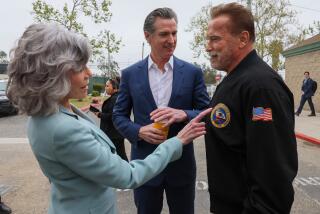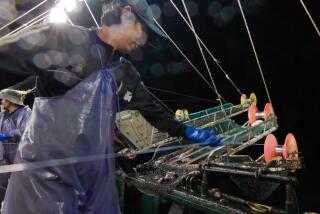A Pep Rally for Fish Ad Campaign : Boosters Gather at Biltmore to Cheer Television Commercials
The seafood industry’s first national advertising campaign was previewed in a pep rally-like atmosphere in downtown Los Angeles last week.
The 200 processors, wholesalers and retailers present at the Biltmore Hotel for the event enthusiastically applauded a screening of the television commercials that will urge Americans to eat more seafood.
The campaign, conceived by the National Fish and Seafood Promotional Council, was warmly received by the audience. In fact, the group even stood and chanted the campaign’s slogan, “Eat Fish and Shellfish Twice a Week,” when encouraged by one of the evening’s speakers.
Generically Promoted
Some in attendance called the effort the “best thing that has ever happened” to the highly segmented and diverse industry. The scene was duplicated, with varying degrees of intensity, in 16 other cities around the country during the past two weeks.
The program marks the first time that fish and shellfish have been generically promoted in broadcast and print media. Among other things, the campaign hopes to stem a one year decline in per capita consumption of fishery products that occurred in 1988.
At present, Americans eat about 15 pounds of seafood annually; a figure that translates into about a one (one-quarter-pound) serving a week. The campaign’s goal is to increase this level by 100%, or more, among people who are already in the habit of buying and preparing fish.
According to research conducted by the council, there seems to be plenty of room for growth. Only 4% of the meals eaten in the home feature seafood, according to polling data provided by the council. The figure jumps significantly, however, for meals eaten out of the home at restaurants, fast food counters and other locations. At least 20% of these meals, the report states, include fish or shellfish.
Funding Deadline
The federally funded council will spend $6.5 million during the current promotion. The effort will purchase air time in October--designated as National Seafood Month--and 1990’s Lenten season, which encompasses February and March. A cartoon character, the Sturgeon General, will preside over the ads and is introduced as “America’s Official Spokesfish.”
“I think we can increase seafood consumption with these efforts,” said Dixie Blake, marketing manager for San Diego-based Ocean Garden Products Inc. and also a member of the seafood promotional council.
The enthusiasm that greeted the presentation, however, may be short-lived. The quasi-governmental council plans to ask individual seafood firms to fund the program when government monies run out in the fall of 1990. Other commodity groups that promote their food products--beef, pork, raisins, strawberries--do not use federal funds.
“You’ve been given a free ride,” Blake told the audience. “There are not likely to be any additional funds from Congress (to extend the program beyond October, 1990).”
The advertising campaign, in the works since 1987, comes at an appropriate time for the fisheries industry.
“We’ve been beaten down pretty good the past few years with increased government regulations, supply fluctuations and negative publicity (over potential contamination),” she said. “This program is a confidence builder for us.”
Although the promotional budget for seafood is a fraction of that allocated for beef or pork, Blake believes that fish processors have aesthetic advantages over some other protein sources.
A Golden Opportunity
“We now have an opportunity to show how beautiful fish is,” she said. “But the guy in a slaughterhouse with a cow carcass can’t really show how great beef is, nor can someone in a chicken plant holding up a broiler.”
Even so, the seafood council will be hard pressed to make a lasting impression on viewers with only $6.5 million to purchase expensive time on radio, cable or network television. The group is hoping the “likable” Sturgeon General cartoon character will help cut through the advertising clutter nonetheless, Blake said.
The council will also economize by advertising only in those regions of the country where seafood consumption is the highest, such as in the Pacific Coast, Northeast and New England regions.
Accompanying the seafood advertising campaign will be a promotional effort to reassure consumers about numerous seafood safety questions that have been raised by the industry’s critics. This program, titled “Navigating Trouble Waters,” is being coordinated by the National Fisheries Institute, a trade group with 1,000 corporate members.
The institute hopes to blunt the often repeated criticism that there is little federal inspection of fishery products. As a result, the group has endorsed Congressional legislation that would establish a government oversight program for all seafood products to replace the current system of infrequent or haphazard safety reviews.
Strong PR Effort
The promotional activities will also attempt to get the industry’s message across to the news media and consumers. Additional efforts are designed to educate food retailers about proper handling of fish being sold in supermarkets.
“We have expanded our public relations efforts to blunt the negative criticism we’ve received,” said Clare Vanderbeek, vice president of the National Fisheries Institute. “Now we will expand it further to restore consumer confidence in our products. We need to bolster confidence that may have been hurt by misinformation in the media. But we also realize that there are some real problems in this industry.”
More to Read
Eat your way across L.A.
Get our weekly Tasting Notes newsletter for reviews, news and more.
You may occasionally receive promotional content from the Los Angeles Times.










